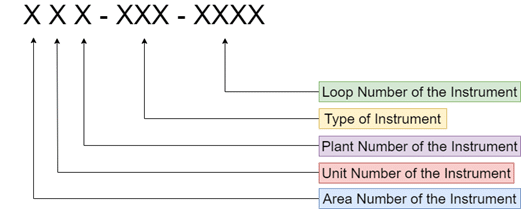Instrument Numbering is the most important for preparing P&ID and other documents related to instruments. In industry, we have many plants. Each plant has different units. These units have many pieces of equipment also. So, for the identification of all this equipment, an instrument numbering philosophy is used.
While preparing the P&ID and other documents, all the instruments are tagged based on a universal standard given by ISA 5.1. This is done to identify and locate the instruments easily in the entire plant.
Tagging Instrument or Instruments Numbering
The basic structure of the instrument numbering philosophy is shown below.

The basic structure of ISA-based numbering philosophy includes:
- Area/Unit/Plant Number
- Instrument Type
- System Number
- Instrument Number
For example, we have a level transmitter and that level transmitter is to be tagged. The level transmitter is located in the heat exchanger. It will be written as
Tag number of level transmitter: 024-LT-3698
Where,
0 – Area Number
2 – Unit Number
4 – Plant number
LT – Level Transmitter3698 – Loop number associated with the particular instrument Area/Unit/Plant Unit Number
The Area/Unit/Plant number will indicate the area, unit, and plant where the instrument is located. In case the project is small and there is no big area involved or does not have many units or plant numbers, a unit number is a basic number.
Example 1: LT-1 or LT- 01 or LT-001
When the project has a few areas, units, or plants, the first digit in the instrument number will indicate the plant number.
Example 2: LT-103 means a level transmitter situated in plant 1.
In case the project is huge and it must be divided into areas, units, or plants, then a prefix must be added before the instrument type.
Example 3: 421-LT-0103
It means a level transmitter situated in Area 4, unit 2, and Plant 1.
Instrument Type
All instruments in a plant have a unique identifying tag which has a series of letters that show the instrument’s function. The naming of instrument type is done by taking ISA 5.1 reference. Some of the instrument types are given below.
| SR. No. | Type of Instrument | Symbol |
| 1 | Pressure Gauge/Indicator | PI |
| 2 | Temperature Gauge/Indicator | TI |
| 3 | Level Gauge/Indicator | LI |
| 4 | Thermocouples | TE(K) |
| 5 | RTD | TE |
| 6 | Pressure Transmitter | PT |
| 7 | Level Transmitter | LT |
| 8 | Flow Transmitter | FT |
| 9 | Temperature Transmitter | TT |
| 10 | Flow Element | FE |
| 11 | Pressure Switch | PS |
| 12 | Differential Pressure Switch | DPS |
| 13 | Differential Pressure Indicating Switch | DPIS |
| 14 | Differential Pressure Transmitter | DPT |
| 15 | Temperature Switch | TS |
| 16 | Temperature Indicating Switch | TIS |
| 17 | Level Switch | LS |
| 18 | I/P Converter | I/P |
| 19 | Position Transmitter | ZT |
| 20 | Control Valve | CV |
Instrument Loop Numbering
The system number and instrument number are together known as the loop number. The loop number shows the loop associated with an instrument. The loop number is helpful in creating loop drawings. ISA 5.1 says that loop numbering can be parallel or series. Hence in a parallel numbering system, we can add a process variable letter with a number for making the tag number unique.
So, there can be a TIC-240, PIC-240 & LIC-240 because all these are unique. Also, these three letters and the number sets are defining different loops. They can be related also, yet they are unique.
This type of numbering system is used when we want to associate equipment related to some specific major equipment. We can take an example of a compressor having the number 240. So, all tags related to the compressor will have a loop number of 240. And if we have 10 such compressors, then we can easily identify instruments related to a particular compressor by this number. (Compressor tags can be 240, 241, 242, …, 249)
This way we can identify each piece of equipment having the same type of installation in different loops.
This means, there can be TIC-101, LT-102, and PIC-103. But there cannot be TIC-101 and PIC-101 because the pressure and temperature variables will get a different number each. This is the simplest system which is the simplest system to use. Hence, it is most commonly used.
Therefore, the numbering system which is chosen for the P&IDs loops must be tested and confirmed for guaranteeing it works as expected with the various software applications used in the plant. Also, it should be noted that loop numbers 001 and 01 are totally different. We cannot ignore a single number or alphabet in a given loop number.